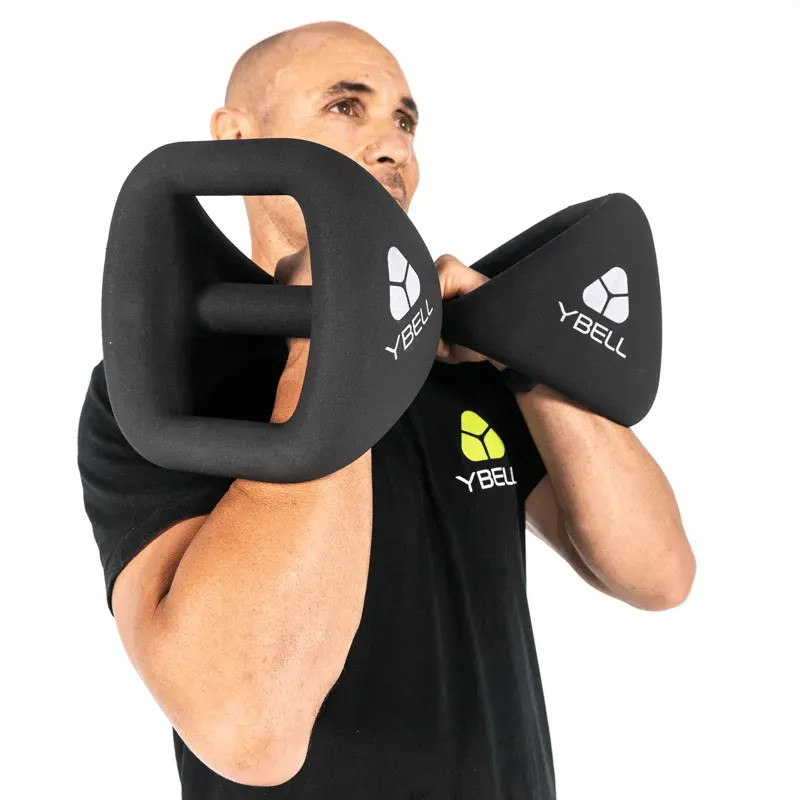Table of Contents
Ever feel like your workout routine is stuck on repeat? You've swung the kettlebell, pressed the dumbbell, and maybe even wrestled with a resistance band, but things feel a bit… familiar. You might have spotted a strange hybrid weight lurking in the corner of a gym or online – something that looks like a kettlebell had a baby with a dumbbell. That's probably a y kettlebell, and it's causing a bit of a stir in the fitness world.
What Exactly is a Y Kettlebell?

What Exactly is a Y Kettlebell?
so you've heard the buzz and are wondering what the heck a y kettlebell is. Picture this: you take a standard kettlebell, chop off the top loop handle, and instead, attach a wider, often padded handle that looks suspiciously like the letter 'Y' when viewed from the side. It’s essentially a hybrid. You still have that familiar weighted bell shape at the bottom, but the handle offers multiple grip options – you can grab the top like a dumbbell, hold the side handles like a kettlebell, or even grip the base for push-ups or other floor work. The whole idea behind the y kettlebell is to combine the functionality of a kettlebell, a dumbbell, and sometimes even a push-up bar into one slightly odd-looking, but potentially very useful, piece of equipment.
How the Y Kettlebell Differs from Regular Kettlebells

How the Y Kettlebell Differs from Regular Kettlebells
The Handle: More Than Just a Loop
so the most obvious difference when you first pick one up is that handle. A standard kettlebell has that single, often thick, loop you grip with one or two hands for swings, cleans, and presses. It’s designed for dynamic movements where the weight swings around your hand. The y kettlebell, though, swaps that loop for a wider, split handle. This split handle lets you grab it like a traditional dumbbell handle on top, or you can grip the sides, mimicking a kettlebell grip. You can even hold the base like a push-up bar. This multi-grip setup is where the real magic, or at least the marketing, happens.
Versatility: One Tool, Many Jobs
Because of that fancy handle, the y kettlebell tries to be the Swiss Army knife of weights. With a regular kettlebell, you're fantastic at swings, snatches, and movements where the weight hangs below your hand. Dumbbells are great for isolation work, presses, rows, and traditional strength exercises. The y kettlebell aims to bridge that gap. You can do your swings and cleans holding the side handles, then immediately switch to a traditional press or bicep curl by gripping the top. It's designed to reduce the need to swap between different pieces of equipment during a workout, which sounds great in theory, right?
- Traditional Kettlebell Swings
- Dumbbell Presses (Chest/Shoulder)
- Goblet Squats (using side or top grip)
- Push-ups (holding the handle or base)
- Dumbbell Rows
- Kettlebell Cleans
Feel and Balance: A Different Beast
Even when you're trying to do a classic kettlebell swing with a y kettlebell, it feels different. The weight distribution isn't quite the same as a traditional bell where the mass is primarily below the handle. With the y kettlebell, the weight feels a bit more centered relative to your grip when using the side handles. This isn't necessarily better or worse, just different. It might change the leverage slightly on certain exercises. When you're using the top grip for dumbbell-style movements, it feels much more like a dumbbell, which is the point. It’s less about the ballistic nature you get from a traditional kettlebell and more about offering grip variety for controlled strength work alongside some dynamic options.
Getting Started: Essential Y Kettlebell Exercises

Getting Started: Essential Y Kettlebell Exercises
First Swings and Presses with Your Y Kettlebell
Alright, you've got this weird-looking weight. Now what? Don't just stare at it. The best way to get a feel for the y kettlebell is to start with some basics you might already know, but adapt them to this new tool. Think about the movements you do with both dumbbells and kettlebells. For instance, a goblet squat is a perfect starting point. You can hold the y kettlebell by the side handles against your chest, just like you would a traditional kettlebell. Feel how the weight sits. Then, try holding the top handle with both hands – it feels more like a heavy dumbbell. See which grip feels more natural or challenging for that particular move. Presses are another good test. Can you press it overhead holding the top handle like a dumbbell? Absolutely. Can you do a single-arm clean and press holding a side handle like a kettlebell? Yep. Start simple, focus on form, and see how the different grips change the exercise feel.
Exploring the Hybrid Grip Advantages
Where the y kettlebell really gets interesting is when you leverage that hybrid handle design for movements that feel awkward with just one type of weight. Take rows, for example. You can do a standard bent-over row holding the top handle like a dumbbell. But you can also do a suitcase row holding the side handle, which feels much like a kettlebell suitcase carry but for a row. Push-ups are another classic example; gripping the side handles off the floor can offer a greater range of motion and might be kinder to your wrists than flat palms. The ability to quickly switch between a dumbbell-style press and a kettlebell-style swing within the same set or circuit without dropping the weight and picking up another is the main selling point. It's about flow and efficiency, or at least that's the pitch.
Exercise | Primary Grip | Benefit |
|---|---|---|
Goblet Squat | Side handles or Top handle | Lower body strength, core stability |
Bent-Over Row | Top handle | Back and bicep strength |
Kettlebell Swing | Side handles | Posterior chain power, cardio |
Overhead Press | Top handle | Shoulder and tricep strength |
Push-ups | Side handles or Base | Chest, shoulder, and tricep strength, increased range of motion |
Suitcase Carry/Row | Side handle (single) | Core stability, grip strength, back strength |
Choosing the Right Y Kettlebell Weight for Your Training

Choosing the Right Y Kettlebell Weight for Your Training
Don't Just Guess: Factors to Consider
so you're sold on the idea of the y kettlebell. Now comes the practical bit: what weight do you actually buy? This isn't like picking up a gallon of milk; getting the weight wrong means either wasting money on something too light that offers no challenge or, worse, getting something too heavy that becomes a dangerous paperweight. You need to think about what exercises you plan to do most often. Are you primarily looking for ballistic movements like swings, or more controlled strength work like presses and rows? Your current strength level with traditional dumbbells and kettlebells is your best starting point. Don't just grab the same weight you swing a kettlebell with; the different handle and balance can feel significantly different, especially for presses or rows.
Consider these points before clicking 'add to cart':
- Your experience level with strength training.
- What exercises you plan to prioritize with the y kettlebell (swings, presses, rows, etc.).
- Your current lifting numbers for similar movements with dumbbells or kettlebells.
- Whether you prioritize form over lifting heavy weight (you should, especially at first).
- Your budget (these aren't always cheap, and you might need more than one eventually).
Start Lighter Than You Think
Seriously, resist the urge to go big right away. It's far better to get a y kettlebell that feels a little too light for some exercises but allows you to nail the form on *all* of them than to get one that's too heavy for most things. Remember, this tool offers multiple grips and movement patterns. A weight that feels okay for a two-handed swing might be completely unmanageable for a single-arm press using the top handle. Get a weight you can comfortably perform about 10-15 reps of a challenging exercise like an overhead press or a single-arm row with good form. You can always increase reps, sets, or workout intensity. You can't magically make a weight lighter once you own it.
Progression Means More Weight (Eventually)
As you get stronger and more comfortable with your y kettlebell, that initial weight will inevitably feel easier. This is a good problem to have, but it does mean you'll likely need to invest in heavier weights down the line if you want to keep progressing. Unlike traditional dumbbells where you might have a whole rack, y kettlebells can take up less space individually, but buying a full set can get pricey. Some people opt for adjustable dumbbells or kettlebells for this reason, but the y kettlebell's unique handle isn't easily replicated in most adjustable formats. Think about your long-term goals. Are you looking for general fitness, or serious strength gains? Your answer will influence whether you need just one versatile weight or a small collection.
Where to Find Your First Y Kettlebell

Where to Find Your First Y Kettlebell
so you've read this far and maybe you're thinking, "Alright, where do I actually get my hands on one of these things?" Finding your first y kettlebell isn't quite as simple as walking into any old sporting goods store and grabbing one off the shelf like a basic dumbbell. They aren't as universally available as traditional weights, but they're definitely out there. Your best bet is usually online retailers. Major platforms like Amazon carry them, often under various brand names. Specialty fitness equipment websites are another good place to look, especially if you're searching for specific weights or higher quality options. Sometimes, even the websites of training programs that utilize the y kettlebell, like TRX, sell them directly. Just be prepared to do a little digging compared to picking up a standard kettlebell.
Final Thoughts on the Y Kettlebell
So, the y kettlebell isn't just another piece of shiny gym equipment destined for the dusty corner. Its unique design genuinely bridges the gap between kettlebells and dumbbells, offering grip options that open up new exercise possibilities. While it won't magically transform you overnight, incorporating a y kettlebell can certainly add a fresh challenge and versatility to your routine, especially if space is limited. Consider its potential for dynamic movements and hybrid exercises. It’s a tool worth exploring if you’re looking to diversify your strength training without cluttering your home gym.